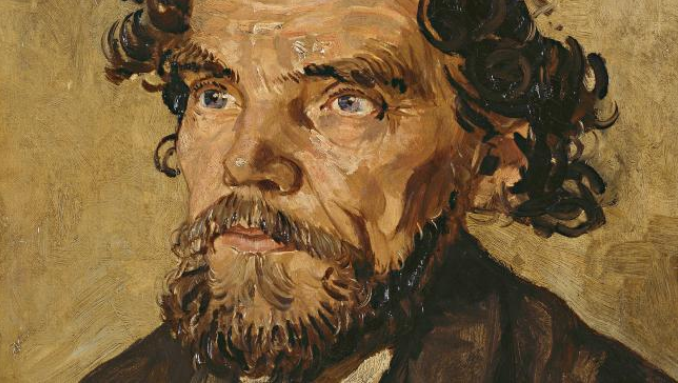
A MILANESE art enthusiast, Antonio De Robertis, claims to have found conclusive proof that a portrait in the National Gallery of Victoria (NGV), classified as anonymous, is by Vincent Van Gogh. It was classified as a Van Gogh before 2006, when the NGV asked the opinion of the Van Gogh Museum in Amsterdam. After stylistic assessment, tracing the provenance, x-rays and pigment tests, the museum said it could not confirm that the proud head with unruly curls was by Van Gogh. Its estimated market value collapsed from US$5 million to as low as $10,000. But now Antonio De Robertis, after years of sleuthing, asserts its authenticity.
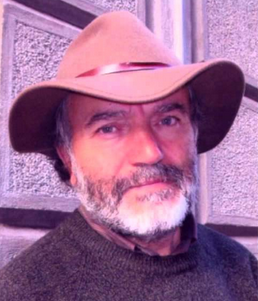 De Robertis (right), seventy-two, who has had character roles in cinema and television films in Italy and the USA, admits to a Van Gogh obsession but is a tenacious investigator rather than a crank. He has been enamoured of Van Gogh’s “absolute honesty in his life and his work” from the age of twenty-one when he was lent a book on the artist. After reading it, he drove with two friends to Van Gogh sites in Paris and Antwerp.
De Robertis (right), seventy-two, who has had character roles in cinema and television films in Italy and the USA, admits to a Van Gogh obsession but is a tenacious investigator rather than a crank. He has been enamoured of Van Gogh’s “absolute honesty in his life and his work” from the age of twenty-one when he was lent a book on the artist. After reading it, he drove with two friends to Van Gogh sites in Paris and Antwerp.
In 1990 he won 100 million lire in an Italian television game show, Lascia o Raddoppia? (Double or Quit?) He did not abandon his work as a surveyor but used half his windfall for trips to galleries in and outside Italy, with his wife Gabriella and two children, and also to buy expensive art books.
What does his wife think of his love for another man? “My family panics when I mention Van Gogh,” admits De Robertis, “but they’re patient as they know he’s my life—I feel most alive when I’m on his track.” Since 1990 he has written over a thousand articles for Italian and non-Italian media on Van Gogh as well as co-authoring a book on him.
This essay appears in the March edition of Quadrant.
Click here to subscribe
Attribution of art works is a heavily-mined field because it affects both the owner’s prestige and the price of the work. It became particularly controversial in the case of Van Gogh in 1990 after one of his portraits was auctioned for US$82,500,000, at that time the highest price ever paid for a painting. Van Gogh made attribution difficult because he was prolific—he produced over 2000 works before his death, at the age of thirty-seven, in 1890—but gave away many and did not keep records. Moreover Van Gogh is not difficult to copy, according to Daniele Dondè of Cremona, north Italy, who turns out old and new masters with certificates of inauthenticity: “there are a hundred fake Van Goghs in galleries and collections around the world, all catalogued, but no one wants to rock the boat”.
De Robertis is happy to rock the boat. In 1994 he claimed that a Van Gogh, for which the Japanese insurance company Yasuda had paid US$39.9 million, was a fake, and some scholars agreed. However, the Van Gogh Museum had authenticated it. De Robertis’s suspicions were aroused when he learnt later that the Van Gogh Museum had received US$50 million from Yasuda to build a new wing designed by a Japanese architect.
De Robertis is a self-confessed “archives mouse”. He does not do style but provenance, seeking records of change of ownership, acquisition of painting materials, letters and photographs. He argues that logical deductions from sure documents can be more reliable than connoisseurship, which is opinionable, or “scientific” proofs which are often confounded by other scientific tests.
He entered the field of Van Gogh scholarship by tracing fakes but for the last four years has been trying to “reattribute” the NGV Head of a Man. He calls it his “most difficult battle” but had his greatest satisfaction ever in March 2016 on publishing the only photograph of Van Gogh as an adult: “That made me understand the meaning of the word ‘viral’ because it got worldwide attention within a few hours.”
He has clashed with the Van Gogh Museum of Amsterdam, which has 200 Van Gogh paintings and last year attracted more than two million visitors. He is capable of direct action such as his blitz last July when, in front of the museum, he unfolded a huge banner with the photo he found of Van Gogh as an adult and then, inside the museum, distributed a pamphlet contesting its findings about the portrait in Melbourne. This led to a fruitless two-hour discussion with Louis Van Tilborgh, the chief researcher, who guided the examination of the small (33 x 40 cm) portrait.
The painting was displayed as a Van Gogh at the NGV until it was sent to an Edinburgh art gallery in 2006. There critics questioned its authenticity because of its technique, its differences from other Van Gogh portraits and, particularly, the complete ignorance about its whereabouts until it came on the market in 1928.
Gerard Vaughan, then director of the NGV, initially had maintained that it was a “transitional” work by Van Gogh, whose style was evolving. However, the Van Gogh Museum’s summary report of its examination said that it had more differences than similarities with other works by Vincent. It did not say it was a forgery: who would copy the style of a tyro who had not yet sold any paintings? It suggested it was by a contemporary of Van Gogh, but no other works of this alleged contemporary have surfaced. The report did not identify the sitter.
De Robertis, who says the NGV “should have defended its Van Gogh”, claims to have identified the sitter and also the itinerary of the portrait since its creation.
 Is the man circled Van Gogh? De Robertis is convinced it is.
Is the man circled Van Gogh? De Robertis is convinced it is.
In the INHA (Institut nationale d’histoire de l’art) Museum of Paris, he found an 1886 photograph (above) of a group of thirty-four art students of various nationalities. He has identified thirty-one, including Van Gogh and Paul Gauguin. There are five Australians: wealthy young John Peter Russell who may have invited the others, John Longstaff, Emanuel Phillips Fox, Tudor St George Tucker and Walter Withers. Russell is close to Van Gogh’s twenty-one-year-old Dutch friend Arthur Briet.
Russell lived opposite the art school where he and his friend Van Gogh studied. In the same building as Russell lived a successful Ukrainian painter, Ivan Pavlovic Pokhitonov. Possibly Russell introduced Van Gogh to Pokhitonov, president of a Russian artists’ club whose patron was his friend the novelist Ivan Turgenev.
In 1886 Van Gogh painted three separate portraits of women. The Van Gogh Museum recognises them as his but has not identified the women. Using photographs of Pokhitonov’s wife, Matilda, and one of her daughters when a young woman, De Robertis has identified the sitters as Matilda, one of her children, and Matilda’s mother who had come to live with them.
According to De Robertis, this establishes Van Gogh’s link with the Pokhitonov family a year before Vincent painted a portrait of Ivan, which has become known as The Head of a Man, and consigned it to him. A Van Gogh Museum researcher, Ella Hendriks, ascertained that the canvas has a similar weave to that used in his aforementioned painting of a woman who De Robertis claims is Matilda. Hendriks’s assessment strengthens De Robertis’s case. Moreover, Hendriks noted that the canvas had been cropped, which could account for the lack of a signature and suggests that originally there may have been a torso also and not solely a head. De Robertis believes that Pokhitonov cropped his portrait to fit the size of the wooden tablet to which he attached it.
What are De Robertis’s other proofs? In 1927 Jacob Baart de la Faille, who was to produce the first comprehensive catalogue of Van Gogh’s work, showed the 1886 photograph of the thirty-four art students to one of them, Arthur Briet, along with a photograph of The Head of a Man. Briet confirmed that the portrait was by Van Gogh, adding that he had known the sitter.
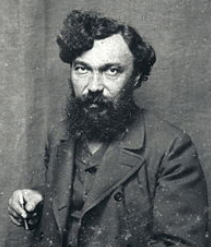 De Robertis’s version, based on documents, circumstantial evidence and deductions, is that Pokhitonov (left) separated from his outspoken wife, Matilda, after she found him in bed with her sister. He left his portrait by Van Gogh with Matilda who, incidentally, became a renowned medical doctor. In the year after her death on June 27, 1926, her three daughters sold the paintings to another Ukrainian painter, Pavel Tchelitchew, and his muse, the English poet Edith Sitwell. On the back of its mahogany support, someone, presumably Tchelitchew, sketched a big-nosed woman who could be Sitwell or one of his friends, the American pair who had a Parisian salon, Gertrude Stein and Alice B. Toklas.
De Robertis’s version, based on documents, circumstantial evidence and deductions, is that Pokhitonov (left) separated from his outspoken wife, Matilda, after she found him in bed with her sister. He left his portrait by Van Gogh with Matilda who, incidentally, became a renowned medical doctor. In the year after her death on June 27, 1926, her three daughters sold the paintings to another Ukrainian painter, Pavel Tchelitchew, and his muse, the English poet Edith Sitwell. On the back of its mahogany support, someone, presumably Tchelitchew, sketched a big-nosed woman who could be Sitwell or one of his friends, the American pair who had a Parisian salon, Gertrude Stein and Alice B. Toklas.
That same year, 1927, it was sold to the Parisian dealer Paul Rosenberg, who had it authenticated by de la Faille. Before doing so he showed it to Arthur Briet, whose testimony convinced de la Faille to include it in his first Van Gogh catalogue. Rosenberg sold it to the Hermann Abels Gallery of Cologne.
In the Paul Rosenberg archive at the New York Museum of Modern Art, De Robertis has found a Rosenberg–Abels exchange of letters in September 1927 about a Van Gogh painting. The letters do not specify which Van Gogh they refer to but, in the 1928 de la Faille catalogue, The Head of a Man is the only Van Gogh in Abel’s hands, which indicates this was the painting which came from Rosenberg. Abels asked Rosenberg who was the previous owner but Rosenberg responded it was not his policy to provide such information.
The Abels letter, together with Arthur Briet’s testimony to de la Faille that Van Gogh had painted The Head of a Man, are decisive in De Robertis’s argument. His other claims are interesting but not crucial.
From Abels’s gallery, the painting was sold to a client in Germany and exhibited in several galleries. However, because of Nazi pressure, it was auctioned in Amsterdam in 1933 together with 119 other works of the same collector.
The Head of a Man was bought by a freelance dealer, Guy Stein, who in turn sold it to an Englishman, David Eccles. As Eccles’s wife did not like it, it was sold again to a career RAF officer, Victor Cazalet. In 1939, after having it reframed, Cazalet forwarded it and another Van Gogh to Adelaide for a touring exhibition of modern art organised by Keith Murdoch. Cazalet died in a wartime plane crash in Gibraltar. In 1940, the Felton Bequest bought The Head of a Man for the NGV for £2196.
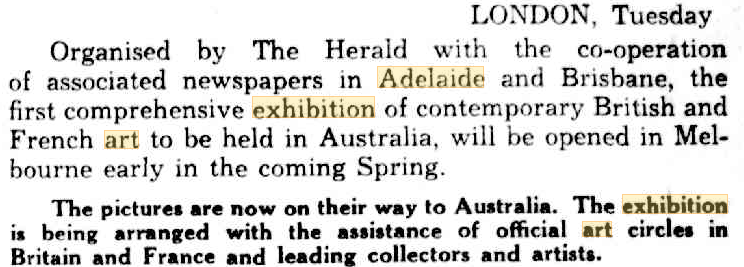 The Melbourne Herald of July 5, 1939, announces the touring exhibition.
The Melbourne Herald of July 5, 1939, announces the touring exhibition.
De Robertis’s tracing of episodes of the painting’s provenance has added vital new elements to the authenticity claim which has been sustained also by others such as the French author Benoit Landais. A reader of the Melbourne Age contributed to the authenticity case after noting that a man’s head on the dust-jacket of a Dostoevsky novel, based on a 1882 portrait of Pokhitonov by his friend Ilia Repin, resembled the NGV portrait.
Hugh Hudson of Melbourne University wrote a devastating, detailed review of the Van Gogh Museum’s summary report, claiming it did not substantiate its decision to turn thumbs down on a painting “manifestly in the style of Van Gogh”. Hudson argued that not enough tests were made, the comparisons with acknowledged Van Gogh paintings were insufficient, the interpretations inconsistent and the propositions untenable. The trenchant criticism extended to the NGV because Hudson said the background information it issued about the report “overstated certain findings”. In 2014 he asked both the Van Gogh Museum and the NGV to reopen investigations. His criticisms were so specific and damning that they required a public response from the two institutions. But none came.
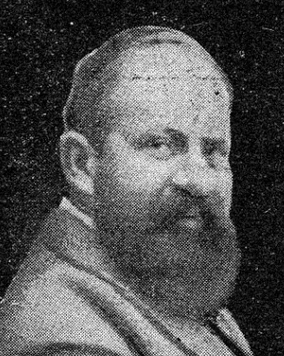 The first English owner, David Eccles, wrote a memoir which mentioned that the previous owner had been persecuted by the Nazis but did not name him. In 1991 a Zurich lawyer, Olaf Ossmann, discovered that the man was Richard Semmel (left), a Pole who became a pre-war textile manufacturer and art collector in Germany, owning many masterpieces by artists such as Titian, Tintoretto, Monet and Manet. This was a game-changer because the Washington Principles of 1998 recommended a “fair and just solution” for those deprived of art works by Nazi persecution. Australia was one of the forty-four signatories to these Principles.
The first English owner, David Eccles, wrote a memoir which mentioned that the previous owner had been persecuted by the Nazis but did not name him. In 1991 a Zurich lawyer, Olaf Ossmann, discovered that the man was Richard Semmel (left), a Pole who became a pre-war textile manufacturer and art collector in Germany, owning many masterpieces by artists such as Titian, Tintoretto, Monet and Manet. This was a game-changer because the Washington Principles of 1998 recommended a “fair and just solution” for those deprived of art works by Nazi persecution. Australia was one of the forty-four signatories to these Principles.
Semmel had fled to New York on the eve of the war and, after it, tried to recover the paintings he had sold hurriedly through the Amsterdam auction. He had little success and in 1950 the widower died penniless in New York, bequeathing his paintings to the woman who had looked after him in his last years. She left them to her grandchildren, two sisters now in their seventies, who live in South Africa. Olaf Ossmann represents them in efforts to obtain restitution of the paintings which Semmel had to sell under duress. He has had some success but in many cases, even from public galleries, he has met with dour resistance.
But not from the NGV. In 2014 its director, Terry Ellwood, agreed that the painting rightfully belonged to the South African spinsters. His predecessor had agreed that it was not a Van Gogh; Ellwood that it did not belong to NGV.
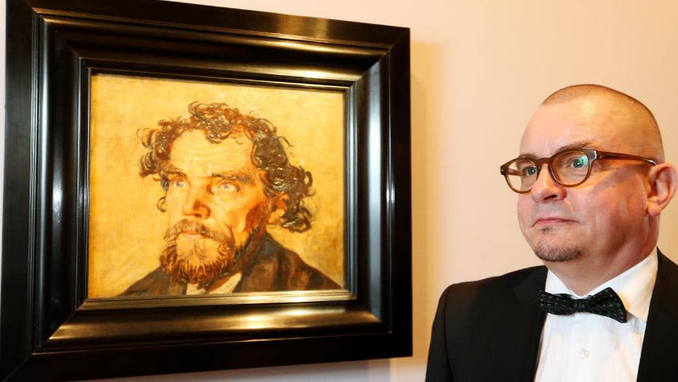 Olaf Ossmann with the disputed portrait.
Olaf Ossmann with the disputed portrait.
Interviewed by phone in Zurich, Ossmann said that the owners’ agreement with the NGV is that either party can terminate the portrait’s time at the gallery by giving six months notice but, at the moment, the two sisters had no intention of doing so.
How many works owned by Semmel have been given back?
“Fifteen of more than a hundred. We haven’t managed to find the whereabouts of seventy.”
This implies that more owners have refused to return them than those who did. Have any been sent to South Africa, and where are they kept once there?
“Some have gone to South Africa but the owners maintain a reserve to avoid the works, or themselves, being targeted. One has been sold to cover the costs of the search. It would be ideal to reassemble the collection and put it on public display but we’re a long way from that.”
What will happen to the Van Goghs when the sisters die?
“They have children and a relative who is an art historian.”
Would the owners sell The Head of a Man to the NGV?
“They might but, of course, the price would depend on whether its authenticity is proved.”
What do you think of De Robertis’s arguments?
“I’m not in disagreement with him and I know an art historian, here in Zurich, who has been convinced by him.”
Presumably this is a reference to the well-known art historian Walter Feilchenfeldt who, even after the Van Gogh Museum downgraded The Head of a Man, included it in his catalogue of Van Gogh’s works.
“That said,” continued Ossmann, “some details of De Robertis’s account of the painting’s itinerary have not yet been proved scientifically. For instance, the story of Pokhitonov’s wife and the painting is plausible but not proved. Computer examinations of the photos of Pokhitonov’s family are under way and could be decisive. One important factor is that Semmel carefully checked the authenticity of everything he bought.”
Can the verdict of the Amsterdam museum be overturned?
“The verdict is only an opinion: simply that it could not confirm that it’s a Van Gogh.”
As owner of the biggest collection of Van Goghs, it must have a certain authority.
“I’d say it has power because criticism of the Van Gogh Museum means you’ll never receive its collaboration afterwards nor will it lend you its paintings. NGV’s acceptance of its opinion was followed by many loans it gave last year for the big Van Gogh exhibition in Melbourne. I understand the NGV’s politics but don’t agree with them. In my opinion, it should be pushing hard for further research into the painting’s authenticity.”
De Robertis wrote to the Victorian government explaining why the NGV should reclaim The Head of a Man as a Van Gogh. On July 20, 2018, he was told that Martin Foley, Victoria’s Minister for the Creative Arts, was considering his letter. At the end of October he received a letter from Alison Lee, assistant director of the NGV, saying that “reauthentification” of The Head of a Man was a matter for its lenders.
The final irony is that, if Van Gogh’s authorship is accepted, it could cost the NGV well over $5 million to re-buy The Head of a Man.
Desmond O’Grady is an Australian author and journalist who lives in Rome. His latest book is a revised edition of his biography of Raffaello Carboni, Raffaello! Raffaello!, published by Arcadia in 2018.
 Sign In
Sign In 0 Items (
0 Items ( Search
Search










I love this painting, and have since I first saw it years ago. It’s astonishingly good, and worthy of being considered equal to Van Gogh’s genius even if it isn’t by him. I’ll buy it if no one wants it!
They had better hurry up as it is only 12-years until the world stops turning and we all fall off …